Homo Habilis
Homo habilis is an extinct species of the Homo genus that lived approximately 2.4 million to 1.4 million years ago in the Early Pleistocene period. The name "homo habilis" means "handy man," reflecting the tool-making abilities of this species.
Physical Characteristics
- Brain size: Smaller than modern humans, with an average brain capacity of about 600 to 750 cubic centimeters.
- Body size: Shorter and smaller than modern humans, with an average height of about 3.5 to 4.5 feet.
- Tool use: Homo habilis is known for its use of tools, particularly the Oldowan tools, which were simple stone implements used for cutting and scraping.
Habitat and Behavior
Homo habilis is believed to have lived in sub-Saharan Africa, primarily in savannah environments. They were likely scavengers and hunters, using their tool-making abilities to process meat and gather plant foods. Their ability to make and use tools represented a significant step in human evolution.
Study Guide
- What does the name "homo habilis" mean? What does it reflect about this species?
- Describe the physical characteristics of Homo habilis, including brain size, body size, and tool use.
- Where is Homo habilis believed to have lived, and what was their likely behavior in that environment?
- What was the significance of Homo habilis' tool-making abilities in human evolution?
◂Science Worksheets and Study Guides Sixth Grade. Birds and Mammals
Study Guide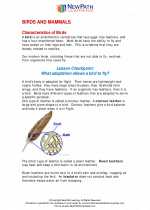 Birds and Mammals
Birds and Mammals  Activity Lesson
Activity Lesson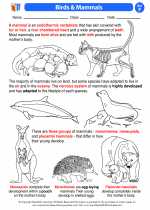 Birds & Mammals
Birds & Mammals  Worksheet/Answer key
Worksheet/Answer key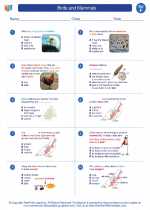 Birds and Mammals
Birds and Mammals  Worksheet/Answer key
Worksheet/Answer key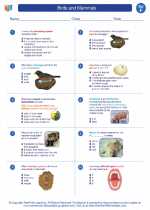 Birds and Mammals
Birds and Mammals  Worksheet/Answer key
Worksheet/Answer key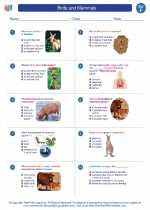 Birds and Mammals
Birds and Mammals  Worksheet/Answer key
Worksheet/Answer key Birds and Mammals
Birds and Mammals  Vocabulary/Answer key
Vocabulary/Answer key Birds and Mammals
Birds and Mammals  Vocabulary/Answer key
Vocabulary/Answer key Birds and Mammals
Birds and Mammals  Vocabulary/Answer key
Vocabulary/Answer key Birds and Mammals
Birds and Mammals  Vocabulary/Answer key
Vocabulary/Answer key Birds and Mammals
Birds and Mammals  Vocabulary/Answer key
Vocabulary/Answer key Birds and Mammals
Birds and Mammals 

 Activity Lesson
Activity Lesson
 Worksheet/Answer key
Worksheet/Answer key
 Worksheet/Answer key
Worksheet/Answer key
 Worksheet/Answer key
Worksheet/Answer key
 Worksheet/Answer key
Worksheet/Answer key
 Vocabulary/Answer key
Vocabulary/Answer key
 Vocabulary/Answer key
Vocabulary/Answer key
 Vocabulary/Answer key
Vocabulary/Answer key
 Vocabulary/Answer key
Vocabulary/Answer key
 Vocabulary/Answer key
Vocabulary/Answer key

The resources above cover the following skills:
LIFE SCIENCE
From Molecules to Organisms: Structures and Processes